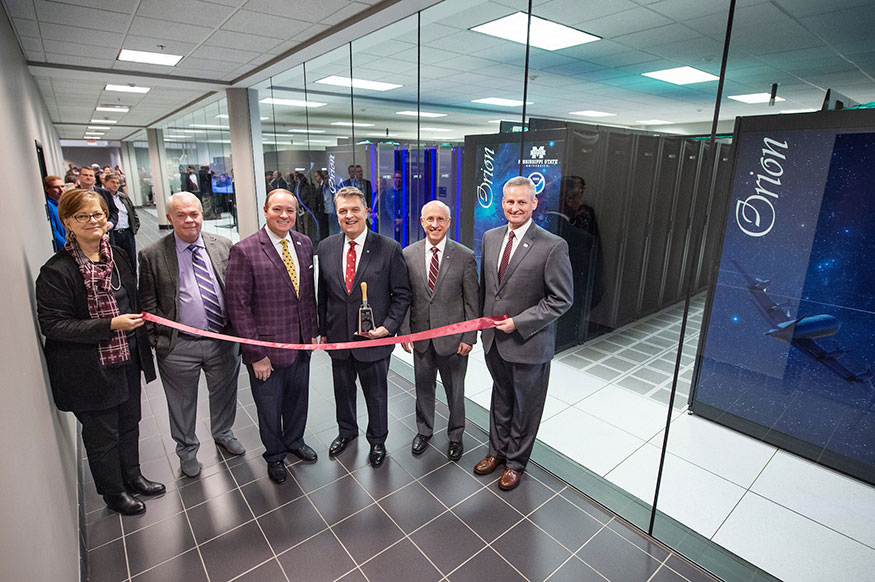MSU, NOAA Celebrate Orion Supercomputer
January 6, 2020

Mississippi State University and National Oceanic and Atmospheric Administration leaders cut a ribbon for the Orion supercomputer, a Dell-EMC system that is the fourth most powerful computer system in U.S. academia. Pictured, from left, is MSU Interim Vice President for Research and Economic Development Julie Jordan, Dell EMC Senior Vice President/Senior Fellow Jimmy Pike, MSU President Mark E. Keenum, NOAA Assistant Administrator for Oceanic and Atmospheric Research Craig McLean, MSU Provost and Executive Vice President David Shaw and MSU Director of High Performance Computing Trey Breckenridge.
PHOTO: Megan Bean | Public Affairs
Mississippi State University and the National Oceanic and Atmospheric Administration celebrated one of the country’s most powerful supercomputers.
MSU and NOAA leaders held a ribbon-cutting ceremony for the Orion supercomputer, the fourth-fastest computer system in U.S. academia. Funded by NOAA and managed by MSU’s High Performance Computing Collaboratory, the system is powering research and development advancements in weather and climate modeling, autonomous systems, materials, cybersecurity, computational modeling and more.
Orion can process 5 petaFLOPS per second, making it the 60th most powerful supercomputer in the world according to Top500.org, which ranks the world’s most powerful non-distributed computer systems. It is housed in the Malcolm A. Portera High Performance Computing Center, located in MSU’s Thad Cochran Research, Technology and Economic Development Park.
“Mississippi State has a long history of using advanced computing power to drive innovative research, making an impact in Mississippi and around the world,” said MSU President Mark E. Keenum. “We also have had many successful collaborations with NOAA in support of the agency’s vital work. I am grateful that NOAA has partnered with us to help meet its computing needs, and I look forward to seeing the many scientific advancements that will take place because of this world-class supercomputer.”
NOAA has provided MSU with $22 million in grants to purchase, install and run Orion. The Dell-EMC system consists of 28 computer cabinets, each cabinet approximately the size of an industrial refrigerator, 72,000 processing cores and 350 terabytes of Random Access Memory.
“We’re excited to support this powerhouse of computing capacity at Mississippi State,” said Craig McLean, NOAA assistant administrator for Oceanic and Atmospheric Research. “Orion joins NOAA’s network of computer centers around the country, and boosts NOAA’s ability to conduct innovative research to advance weather, climate and ocean forecasting products vital to protecting American lives and property.”
MSU’s partnerships with NOAA include the university’s leadership of the Northern Gulf Institute, a consortium of six academic institutions that works with NOAA to address national strategic research and education goals in the Gulf of Mexico region. Additionally, MSU’s High Performance Computing Collaboratory provides the computing infrastructure for NOAA’s Exploration Command Center at the NASA Stennis Space Center. The state-of-the-art communications hub enables research scientists at sea and colleagues on shore to communicate in real time and view live video streams of undersea life.
“NOAA has been an incredible partner in research with MSU, and this is the latest in a clear demonstration of the benefits of this partnership for both the university and the agency,” said MSU Provost and Executive Vice President David Shaw.
Orion supports research operations for several MSU centers and institutes, such as the Center for Computational Sciences, Center for Cyber Innovation, Geosystems Research Institute, Center for Advanced Vehicular Systems, Institute for Genomics, Biocomputing and Biogeotechnology, the Northern Gulf Institute and the FAA Alliance for System Safety of UAS through Research Excellence (ASSURE). These centers use high-performance computing to model and simulate real-world phenomena, generating insights that would be impossible or prohibitively expensive to obtain otherwise.
“With our faculty expertise and our computing capabilities, MSU is able to remain at the forefront of cutting-edge research areas,” said MSU Interim Vice President for Research and Economic Development Julie Jordan. “The Orion supercomputer is a great asset for the state of Mississippi as we work with state, federal and industry partners to solve complex problems and spur new innovations.”
For more on MSU’s High Performance Computing Collaboratory, visit
www.hpc.msstate.edu.
MSU is Mississippi’s leading university, available online at
www.msstate.edu.
